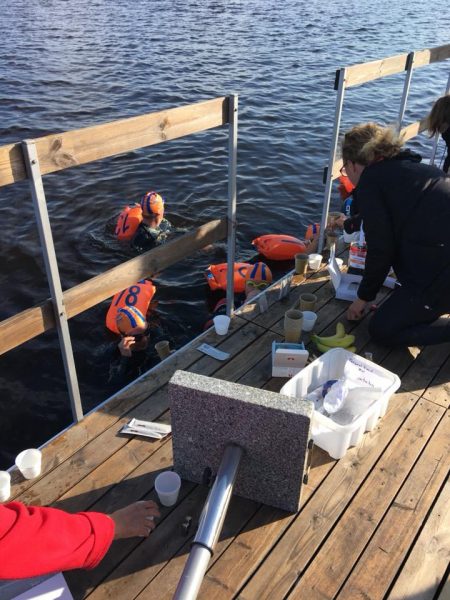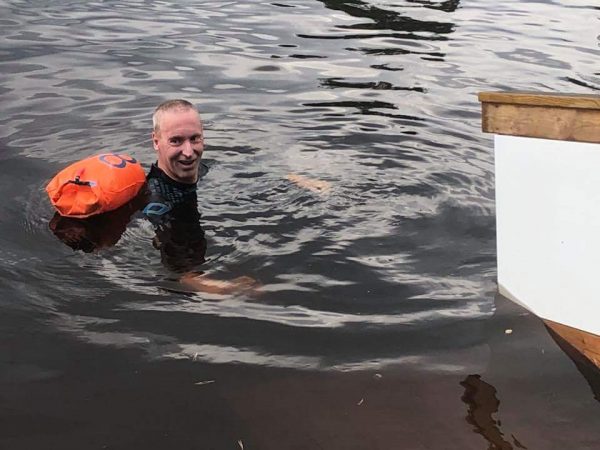Sorry, I tried to keep it short this time (how much can you tell about a swim?), but thàt hasn’t really gone according to plan… So here’s a long story about a long swim…
a short version for the impatient reader (spoiler alert!):
prerace – start – swim (repeat a long time) – finish
After two years with big goals (The Double in 2016 and The Triple in 2017), and a new big plan in the making for 2019 (more on that in a later blog-update… stay tuned…<edit: more on that plan here…> ), 2018 was supposed to be an ‘easy’ year. ‘Easy’ meaning: just a lot of fun stuff to do, and just enjoy myself without the pressure of a training-schedule that’s leading to a terrifying race… But with all the fun and ‘unimportant’ races this year, there was just one goal that I really wanted to achieve this year… A 20km swim!
So this winter I started to look for a nice place to go swimming: I wanted a ‘point-to-point’ course (so not a swim where start and finish are at the same place, I wanted to ‘go somewhere’), and although a solo swim (with someone on a boat for support) would be acceptable, an organised event would be more fun… And then I found the Swedish ‘vidösternsimmet’: a ‘21+km’ swim (that little ‘+’ after the 21km is a nasty one…) which is ‘Sweden’s longest open-water race’ and, according to the website also ‘Sweden’s toughest swimming race’… So, consider me interested 🙂
Coach Jacomina didn’t advise against a goal like this during my ‘easy year’ (which should have had me worried from the start!), and even decided that she would join me for the event (which should have had me even more worried! But it also helped to have some company during the long training-swims!), so we went to Sweden for a little swim (with a little race in Denmark along the way)…
About a week before the swim we hear, through the powers of social media, that the water temperature is over 25°C, and that it’s ‘strongly advised’ to swim without a wetsuit to prevent overheating (for the non-swimmers: the wetsuit doesn’t only help to keep you warm, it also helps with the body-position in the water, and when you’re not the best swimmer, and on a distance like this, it saves a ton of energy…). I decide not to freak out about it, I’m not sure if I can swim the full 21km if I don’t wear my wetsuit (I try and forget about the little ‘+’ after the 21!), so I just see how far I can get…

total: ‘ca’ 21500m…
It was the right call to relax about the temperature-situation, since a storm before the race helped cool down the lake to a nice 20°C, so it would be a nice wetsuit-swim!
A few days before the race we join the local open-water swimmers for their training, and we swim the final 2500 meters of the course. Good to see this part of the course in advance, it will help to know that ‘the little yellow house’ that you can use for navigation really doesn’t get any closer, no matter how hard you swim… But the funniest (and slightly worrying part) of that evening of training is a conversation with one of the local Swedish swimmers:
– ‘Are you doing the 25km saturday?’
me: ‘No, it’s luckily just 21…’
– ‘Haha, that’s why we call it 21 ‘+’ km, nobody swims only 21!!’
me: ‘…’
With a buoy out on every kilometer it’s easy to gain some extra meters while navigating, and on a long distance these extra meters add up… But now it was time to mentally prepare for a long day ahead, and forget about that number ’21’ for a while…
The night before the start the race-briefing is filled with humor, but it’s obvious that the crew knows what they’re doing; safety first, so there’s talk about the boats that are patrolling between the buoys, the protocols for fog or thunder (delayed starts, the race might get temporarily stopped, or eventually cancelled), and because it will be a race for some people (not for me, I’m just trying to get to the finish!) there’s actually a ‘fast food’ and a ‘slow food’ side at the first floating aid-station!
Osudden, Sweden, august 11th, 07:00AM
About 75 swimmers are ready to start, and when the gun goes of there’s a bit of an anti-climax; no-one is in a hurry, since it’s going to be a long day for even the fastest swimmers, and (we’ve been swimming here earlier this week, so we knew this); it will be a 150-ish meter walk through shallow waters before you will be able to swim anyway! During that walk I see Coach Jacomina for the last time during the race (she is doing the ‘non-wetsuit’ swim, and will make it to the other side faster (and colder) than me), and when I start swimming I try to find my ‘slow and lazy’ swimstroke…

floating aid-station
Usually my first 250 meters are way too fast, but now I get into a steady rhythm quite soon, so I feel relaxed and don’t worry about what’s to come… Just swim to the next yellow buoy, and then to the next one, and then to the next one… There are 22 yellow buoys, placed ‘approximately’ 1km apart (do the maths and remember the little ‘+’ after the 21km!) and the plan is simple; eat at every buoy (I have enough energy-bars stuffed in my wetsuit at the ankles to make it to the half-way point, and there I will have a bag with new bars), and use the official aid-stations just to drink.

out of the water at the second aid-station
The swim to the first aid-station (‘approximately’ 3700 meters) is really relaxed, the aid-station is a ‘floating station’ so a few cups of water and I’m back on my way. Feeling strong, eating when I need to, and completely relaxed I swim to the next station (3900m). My mind is empty, and although the buoys don’t seem to have the same definition of a kilometer than my gps-watch has, I won’t let that distract me… At the aid-station another drink, and back onto the longest stage: the next station is about 5500 meters away…
Now it’s time to keep the head in the game; keep eating, keep relaxing, and keep focussing on a steady stroke. But now is also the time that the wind picks up… It’s not a storm, but on a big lake a bit of wind makes for choppy water, and on a long swim a bit of choppy water costs a lot of energy! So I’m working hard, and the next yellow buoy just doesn’t come any closer… It’s a mind game; the trick is to just keep on swimming, and try not to focus on how slow it all seems to go (because the thing with ‘time’ is that it just might starts to move even slower when you focus on it…). Eventually I make it to the 13km point (which, on my watch is now 15km… But I have to say that the watch missed some parts, and added a few extra meters, so the exact distance will forever be a mystery…).
This aid-station is situated at the beach of the campsite we’re staying at, so it’s nice to be ‘home’ for a few minutes! A few drinks in, a little chat with the ‘safety-supervisor’ (who introduced himself during the race-briefing as the ‘security-manager’, until he realised that that translation sounded as if he was working at a night-club, to then state that he was definitely not working at a night club… Did I mention that the briefing was quite funny at times?), and now, back into the water!
My raceplan for this swim was pretty easy from the start; just keep swimming, and if I make it to the 13km station I know that I will make it to the finish, from here it’s just a 3400m stage, and then 2 times 2500m, sounds easy, right? Well, it is still 8.5km to go, but the plan was to never let that thought slip into the mind! And the plan worked… The choppy water of the last 5km did cost me a lot of energy though, so the arms, shoulders, back and neck are getting sore. It’s hard to keep some power in my swim-stroke, so I slow down, and the buoys seem to be getting further apart… But every time when there’s a bit of flat water I can still get into my ‘slow-and-steady-diesel-engine’ so that’s keeping me confident! The next aid-station is (as everywhere on the course!) manned by really friendly volunteers, and I get back into the water for the final 5km (or 5 ‘+’ km?). By now it’s a mental fight; the body is done, but I try to distract myself from what the body is trying to tell me; I’m counting strokes (a few times counting to 250 helps me pass some time), visualise myself finishing, and try every other trick in the book. Meanwhile the wind has picked up again, and I hear thunder in the distance. Every time I hear a boat come closer I fear that the thunder-protocol is put into action, and the race will be cancelled. Off-course; safety first, but it would really suck if I came this far to stop now! (as it turned out; the thunder-storms passed the lake on a safe distance both east and west, so we were lucky enough to have a small safe window in between!).

this is what a tired and happy face looks like after finishing a 9 hour swim…
After the final floating station I start to relax; it’s only about 2500 meters now, and I’ve swum this part before, so I know what to expect! Except I didn’t expect this 2500 meters to be this long… The body is done, and the mind is trying to tell me that now is a nice time to finish… (not a good state-of-mind when there’s still a bit of swimming to go!). The final buoy takes forever, then a short swim to the bridge (which feels as if it’s a lóng swim!), then another 100 meters to the finish… And there it is… My first ever 21+km swim done!
My garmin eventually shows 22.8km, and, as said before, there’s a few meters missing, but also a few meters added, but this swim will go into the books as a 22.8km swim, in 9 hours and 6 minutes…
It was an amazing day out on the water! Thanks to an amazing vidöstern-crew, and really friendly local swimmers, I might just come back one day…

after the race, with Jacomina and race-director Adam
vidösternsimmet
21+km (22.8km)
09’06’25



Leave a Reply